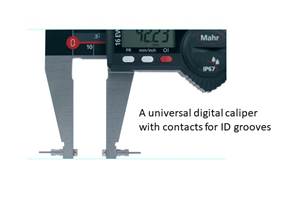Sliced Bread—And The Limits Of Air Gaging
"Air gaging is the greatest thing since sliced bread," a friend once said. And he was right—air gaging is good.
Share




.png;maxWidth=45)
DMG MORI - Cincinnati
Featured Content
View More

Autodesk, Inc.
Featured Content
View More
Takumi USA
Featured Content
View More"Air gaging is the greatest thing since sliced bread," a friend once said. And he was right—air gaging is good. It's fast, high resolution, non-contact, self-cleaning and easy to use. For use in a high-volume shop, it's hard to beat. That begs the question, "If air gaging is so good, why would you ever consider going back to contact type gaging?"
The answer is that while air gaging does provide all of the benefits listed above, it—and everything else that obeys the laws of physics—has some limitations. There are, in short, some trade-offs, and for every advantage you gain in the measuring process with air, you will have to pay the price and sacrifice something else. The real question is, "What are those limitations, and how can you best work with them?"
Air gaging gives you a fast measurement device that provides superior reliability in the dirtiest shop environment, but you give up things such as measurement range and a clear delineation of surface. Air gaging has about 10 to 20 percent of the range of a typical electronic transducer with similar resolution.
The response of air to surface finish, however, is more complicated. Think of an air jet. The measurement ‘point' is really the average area of the surface the jet is covering. Now consider the finish, or roughness, of that surface. The measurement point of the air jet is actually the average of the peaks and valleys to which the jet is exposed. This is not the same measured point you have if a contact-type probe is used. This difference is a source of real gaging error, and one that is most often apparent when two different inspection processes are used.
For example, let's say we have a surface finish of 100 microinches on a part and we're measuring with an air gage comparator and two-jet air plug that has a range typically used to measure a 0.003-inch tolerance. The typical gaging rule says you should have no sources of error greater then 10 percent of the tolerance. In this example, that's 0.0003 inch. If we used this plug on the 100-microinch surface, the average measuring line is really 50 microinches below the peak line. Double this error with two jets and you get 0.0001 inch or 30 percent of the allowable error. That's pretty significant, so air would probably not be a good choice for this part. In general, the limit for surface finish with an air gage is about 60 microinches, but it really depends on the part tolerance.
This source of error should also be considered when setting the plug and comparator to pneumatic zero. If the master and the part have similar surface finishes, then there is little problem. Most master rings are lapped to better than a 5-microinch finish. However, if the gage is now used on a 200-microinch finish part, there would be significant error introduced. For most applications, there should be no more than 50 microinches difference between the master and the part the gage is measuring. Even this can be significant if the tolerance of the part is as little as 0.001 inch.
In some applications, air gaging can be the best thing since sliced bread. In others, you can get in trouble with the butter. When measuring porous surfaces, narrow lands, and areas extremely close to the edge of a hole, stick with a fixed size, mechanical plug with probe contacts.
Related Content
Choosing the Correct Gage Type for Groove Inspection
Grooves play a critical functional role for seal rings and retainer rings, so good gaging practices are a must.
Read MoreHow to Calibrate Gages and Certify Calibration Programs
Tips for establishing and maintaining a regular gage calibration program.
Read MoreThe Link Between CNC Process Control and Powertrain Warranties
Ever since inventing the touch-trigger probe in 1972, Sir David McMurtry and his company Renishaw have been focused on achieving process control over its own manufacturing operations. That journey has had sweeping consequences for manufacturing at large.
Read More6 Machine Shop Essentials to Stay Competitive
If you want to streamline production and be competitive in the industry, you will need far more than a standard three-axis CNC mill or two-axis CNC lathe and a few measuring tools.
Read MoreRead Next
Setting Up the Building Blocks for a Digital Factory
Woodward Inc. spent over a year developing an API to connect machines to its digital factory. Caron Engineering’s MiConnect has cut most of this process while also granting the shop greater access to machine information.
Read MoreBuilding Out a Foundation for Student Machinists
Autodesk and Haas have teamed up to produce an introductory course for students that covers the basics of CAD, CAM and CNC while providing them with a portfolio part.
Read MoreRegistration Now Open for the Precision Machining Technology Show (PMTS) 2025
The precision machining industry’s premier event returns to Cleveland, OH, April 1-3.
Read More








.png;maxWidth=150)
























.jpg;maxWidth=300;quality=90)












